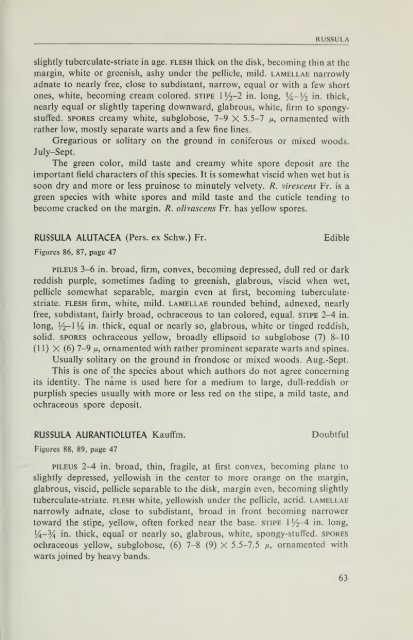Create successful ePaper yourself
Turn your PDF publications into a flip-book with our unique Google optimized e-Paper software.
RUSSULA<br />
slightly tuberculate-striate in age. flesh thick on the disk, becoming thin at the<br />
margin, white or greenish, ashy under the pellicle, mild, lamellae narrowly<br />
adnate to nearly free, close to subdistant, narrow, equal or with a few short<br />
ones, white, becoming cream colored, stipe 1 )/2-2 in. long, i4-J/2 in. thick,<br />
nearly equal or slightly tapering downward, glabrous, white, firm to spongy-<br />
stuffed. SPORES creamy white, subglobose, 7-9 X 5.5-7 m, ornamented with<br />
rather low, mostly separate warts and a few fine lines.<br />
Gregarious or solitary on the ground in coniferous or mixed woods.<br />
July-Sept.<br />
The green color, mild taste and creamy white spore deposit are the<br />
important field characters of this species. It is somewhat viscid when wet but is<br />
soon dry and more or less pruinose to minutely velvety. R. virescens Fr. is a<br />
green species with white spores and mild taste and the cuticle tending to<br />
become cracked on the margin. R. olivascens Fr. has yellow spores.<br />
RUSSULA ALUTACEA (Pers. ex Schw.) Fr. Edible<br />
Figures 86, 87, page 47<br />
PILEUS 3-6 in. broad, firm, convex, becoming depressed, dull red or dark<br />
reddish purple, sometimes fading to greenish, glabrous, viscid when wet,<br />
pellicle somewhat separable, margin even at first, becoming tuberculate-<br />
striate. FLESH firm, white, mild, lamellae rounded behind, adnexed, nearly<br />
free, subdistant, fairly broad, ochraceous to tan colored, equal, stipe 2-4 in.<br />
long, Yi-l )4 in. thick, equal or nearly so, glabrous, white or tinged reddish,<br />
solid. SPORES ochraceous yellow, broadly ellipsoid to subglobose (7) 8-10<br />
(11) X (6) 7-9 M, ornamented with rather prominent separate warts and spines.<br />
Usually sohtary on the ground in frondose or mixed woods. Aug.-Sept.<br />
This is one of the species about which authors do not agree concerning<br />
its identity. The name is used here for a medium to large, dull-reddish or<br />
purphsh species usually with more or less red on the stipe, a mild taste, and<br />
ochraceous spore deposit.<br />
RUSSULA AURANTIOLUTEA Kauffm. Doubtful<br />
Figures 88, 89, page 47<br />
PILEUS 2-4 in. broad, thin, fragile, at first convex, becoming plane to<br />
slightly depressed, yellowish in the center to more orange on the margin,<br />
glabrous, viscid, peUicle separable to the disk, margin even, becoming slightly<br />
tuberculate-striate. flesh white, yellowish under the pellicle, acrid, lamellae<br />
narrowly adnate, close to subdistant, broad in front becoming narrower<br />
toward the stipe, yellow, often forked near the base, stipe 1 )/2-4 in. long,<br />
Va-Va<br />
in. thick, equal or nearly so, glabrous, white, spongy-stuffed, spores<br />
ochraceous yellow, subglobose, (6) 7-8 (9) X 5.5-7.5 /x, ornamented with<br />
warts joined by heavy bands.<br />
63

















